Atul Kulshrestha1, Mukesh Kumar Gupta1, Om Prakash Mahela2
1Department of Electrical Engineering, Suresh Gyan Vihar University, Jaipur-302017, India, India
(Email: agijaipuratul@gmail.com, mkgupta72@gmail.com)
2Power System Planning Division, Rajasthan Rajya Vidhyut Prasaran Nigam Ltd., Vidyut Bhawan, Jaipur, India
(Email: opmahela@gmail.com)
Abstract— This paper has designed a current based method using db4 mother wavelet of Discrete Wavelet transform (DWT) and decision rules for detection of faulty events incident on the distribution network (DN) where penetration level of both the wind and solar energy is present. Algorithm can be used for protection of the DN by continuously monitoring the current signals. Investigated faulty events are phase to ground (LG) fault, phase to phase (LL) fault, two phases to ground fault (LLG) and three phases to ground (LLLG) fault. Study is performed on a test DN modeled using IEEE-13 node test system in MATLAB where a solar photovoltaic (PV) power plant and wind power plant (WPP) are integrated. Performance of algorithm is established by comparing with a method reported in literature which is also based on DWT but using different features.
Keywords— Discrete Wavelet transform; Distribution network; Faulty event; Renewable energy; Solar energy; Wind energy.
1. Introduction
Number of grid connected large size Renewable energy (RE) power plants are continuously increasing. These plants help to meet the increased load demand by environmental friendly energy with reduced carbon emission. However, these energy sources generate power which is variable in nature and also uncertain to generate power. This resulted to initiate technical challenges for the power utilities like variations in the grid frequency, voltage variations, reduced efficiency of equipment, power quality (PQ) problems, deterioration in grid stability, reduced power reliability, and protection issues [1]-[3]. Protection issues need to be investigated for increasing the performance of protection schemes by the use of signal processing and intelligent techniques. Fault identification and their classification is a key issue which can be analysed using the signal processing techniques. Ola et al. [4], presented a method for detection and categorization of faults incident on the power network where generation from WPP is available using Stockwell transform (ST) based median feature. This technique has demerits of high computational complexity. In [5], authors has designed a techniques which is effective for identification and categorization of faulty scenarios incident on the grid of utilities where solar energy integrated by the application of DWT and rule based decision tree (RBDT). This method has not been tested for generation from various types of the RE generators in the hybrid grids. In [6], authors have proposed a scheme for the protection of transmission lines using the K-means clustering and linear regression techniques. Method is effective for identification and classification of faults incident on the transmission line. In [7], a technique for identification of faults incident on the transmission line to provide effective protection using hybrid combination of Wigner distribution function (WDF) and DWT is investigated. A technique using the combination of DWT and HT for identification and classification of faulty events incident on the DN in the presence of solar energy by processing the voltage and current signals is presented by the authors in [8]-[9]. Combination of features computed using the ST and HT to detect faults on transmission line feeding the dynamic loads for designing protection scheme is introduced in [10]-[11]. Transmission line fault detection method using ST for utility grid with wind energy generation is introduced in [12]. In [13], authors investigated a method for detection of faults incident on the network of power system when Thyristor Controlled Reactor (TCR) devices are used in the network to control the reactive power. In [14], authors designed a current supported scheme using Harmonic Wavelet Transform (HWT) and RBDT to provide effective protection to the transmission lines. ST supported technique using median features is designed for transmission line protection by the authors in [15]. Various techniques for fault detection in the utility grids with and without the presence of RE generation to design protection schemes are reported in [16]-[25]. Following are main contributions of this paper:-
- A current based technique using DWT and decision rules is introduced for detection of faulty events incident on the DN where penetration level of both the wind and solar energy is high.
- Investigated faulty events are LG, LL, LLG and three phases to ground (LLLG) fault.
- Performance of algorithm is established by comparing with a method reported in literature which is also based on DWT but using different features and study is performed on IEEE-13 nodes test system in MATLAB/Simulink environment.
The paper is divided into seven sections. Introduction of the research activity is included in Section 1. Test system with integrated wind and solar power plants is described in Section 2. Proposed techniques for faulty event recognition are illustrated in Section 3. Results of simulation and their discussion is included in Section 4. Fault classification is described in Section 5. Section 6, describes the performance comparative study. Section 7, includes the conclusion of the research activity.
2. Test Distribution Grid with RE Generators
IEEE-13 bus test feeder is utilized for the proposed study of fault estimation. A solar PV system of capacity 1 MW integrated on bus 680 and two wind generators of capacity 1.5 MW are integrated on buses 646 and 675 of the test IEEE-13 bus test system. It is operated at a frequency of 60 Hz. The original test system is rated at capacity of 5 MVA. It is operated on two voltage levels of 4.16 kV, 0.48 kV with the help of transformer (XFM-1) connected between the nodes 633 and 634 [26]. Proposed test system interfaced with wind and solar power plants is illustrated in Fig. 1. The line data with interconnection used in the proposed grid are described in the Table 1. The data related to load and capacitors are described in the Tables 2 and 3 respectively. Load models are star-connected and constant P and Q type. All the lines used in the proposed grid are three phase overhead lines. The proposed test system is integrated to the utility grid with the help of substation transformer. The 1MW solar PV plant is connected to the node 680 through transformer XSPV and 5 km long overhead transmission line. The 1.5 MW doubly fed induction generator based wind power plants are integrated to the node 675 (WG-1) and 646 (WG-2) through transformer XWG. The DC to DC boost converter and DC to AC inverter are used in the test system to incorporate the solar PV system to the test system.
The details of transformers used in the test grid are provided in Table 4. The switch between nodes 671 and 692 of the test system is modelled using a three pole circuit breaker (CB). Line segments are considered with length equal to that used in original test network. Solar PV data and wind generator data reported in [27]-[29] has been utilized for this study.
- Details of Lines Used in the Test Grid
| Node A | Node B | Length(ft.) | Configuration |
| 632 | 645 | 500 | 601 |
| 632 | 633 | 500 | 601 |
| 633 | 634 | 0 | XFM-1 |
| 645 | 646 | 300 | 601 |
| 650 | 632 | 2000 | 601 |
| 684 | 652 | 800 | 601 |
| 632 | 671 | 2000 | 601 |
| 671 | 684 | 300 | 601 |
| 671 | 680 | 1000 | 601 |
| 671 | 692 | 0 | Switch |
| 684 | 611 | 300 | 601 |
| 692 | 675 | 500 | 601 |
- Details of Loads Used in the Test Grid
| Node | Load Quantity (kW) | Load Quantity (kVAr) |
| 634 | 400 | 290 |
| 645 | 170 | 125 |
| 646 | 230 | 132 |
| 652 | 128 | 86 |
| 671 | 1155 | 660 |
| 675 | 843 | 462 |
| 692 | 170 | 151 |
| 611 | 170 | 80 |
- Details of Capacitors Used in Test Grid
| Node | Ph-A (kVAr) |
| 675 | 600 |
| 611 | 100 |
- Details of Transformers Used in the Test Grid
| Transformer | kVA | kV-high | kV-low | R – % | X – % |
| Substation: | 5,000 | 115 – D | 4.16 Gr. Y | 1 | 8 |
| XFM -1 | 500 | 4.16 – Gr.W | 0.48 – Gr.W | 1.1 | 2 |
| XSPV | 500 | 4.16 Gr. Y | 0.260- Gr. Y | 1.1 | 2 |
| XWG | 5000 | 4.16 Gr. Y | 0.575- Gr. Y | 1.1 | 2 |
- Test system with RE generation.
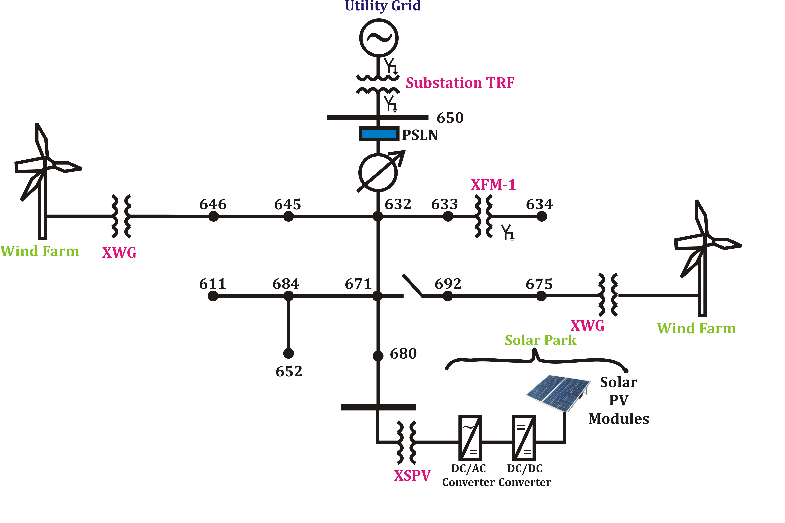
3. Proposed Fault Detection Algorithm
The algorithm used for detection of the faults and based on the DWT and RBDT is detailed below. The feeder between the nodes 632 and 671 has been used to simulate the various types of the faults. The following are main steps utilized in detection of faults:-
- Simulate the various types of faults at middle of the feeder connected in between nodes 632 and 671 of IEEE-13 bus test network modeled as test grid and incorporating wind and solar PV systems.
- Capture current waveforms on the node 650 of test grid.
- Process the signals of the current by application of the DWT with db4 as mother wavelet.
- Obtain the proposed fault index with the help of following sequence/operations on the detail and approximation coefficients. The fault index proposed is represented by FI.
A= CD1.*CD1
B= CD1.*CD1
FI=A.*B
- Compute threshold magnitude of FI to differentiate the faulty and healthy phases as well as different types of the faults.
- This process is repeated for all types of the faults which are studied in this paper.
4. Simulation Results
Results of simulation pertaining to detection of faults in test grid where generation from both the wind and solar power is available and their discussion are described in this section. Investigated faults include LG, LL, LLG and LLG faults.
- Line to Ground Fault
A fault of LG type is performed on phase-A at middle of the line connected between the nodes 632 and 671 of the test system in the simultaneous presence of the wind and solar PV power generation. The current of phase-A recorded on bus 632 of the test system has been processed using DWT with the help of db4 mother wavelet for four decomposition levels. Proposed fault index is calculated from the detailed coefficient at first level of decomposition and provided in Fig. 2. This can be inferred from Fig. 2 that magnitudes of proposed fault index are zero in both the pre-fault and post fault conditions. However, these values are high and equal to 9×107 during the events of LG fault indicating occurrence of the fault in the test grid. A threshold value equal to 5×107 has been selected for discrimination of the LG fault from the other faults as well as the faulty phase from the healthy phases during the event of LG fault. The values of proposed fault index higher than 1×106 indicates the presence of the fault in the test grid network.
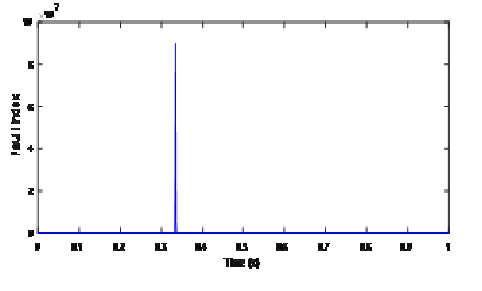
- FI for current in phase-A during LG fault on phase-A.
The line to ground (LG) fault is created on the phase-A at middle of the line connected between the nodes 632 and 671 of the test system in the simultaneous presence of the wind and solar PV power generation. The current of phase-B recorded on bus 632 of the test system has been processed using DWT using db4 as mother wavelet for four decomposition levels. Proposed fault index is calculated from the detailed coefficient at first level of decomposition and provided in Fig. 3. This is inferred from Fig. 3 that magnitudes of proposed fault index are zero in both the pre-fault and post fault conditions. However, these magnitudes are high equal to 13×104 but less than the threshold value of 1×106 indicating the healthy phase during the event of LG fault.
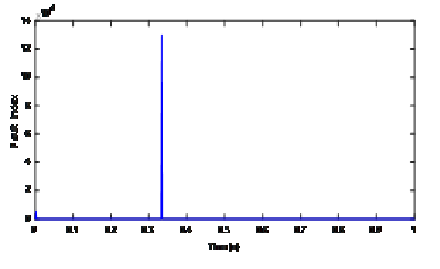
- FI for current in phase-B during LG fault on phase-A.
The line to ground (LG) fault is created on the phase-A at middle of the line connected between the nodes 632 and 671 of the test system in the simultaneous presence of the wind and solar PV power generation. The current of phase-C recorded on bus 632 of the test system has been processed using DWT using db4 as mother wavelet for four decomposition levels. Proposed fault index is calculated from the detailed coefficient at first level of decomposition and provided in Fig. 4. This can be inferred from Fig. 4 that magnitudes of proposed fault index are zero in both the pre-fault and post fault conditions. However, these values are high and equal to 12×104 but less than the threshold value of 1×106 indicating the healthy phase during the event of LG fault.
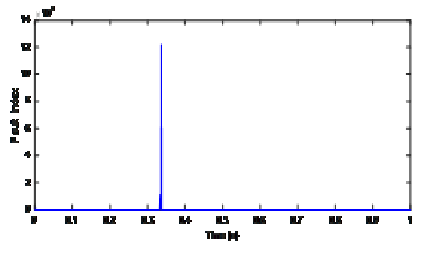
- FI for current in phase-C during LG fault on phase-A.
- Double Line Fault
The double line (LL) fault is created by short circuiting the phases-A&B at middle of the line connected between the nodes 632 and 671 of the test system in simultaneous presence of the wind and solar PV power generation. The current of phase-A recorded on bus 632 of test system has been processed using DWT using db4 mother wavelet for four decomposition levels. Proposed fault index is calculated from the detailed coefficient at first level of decomposition and provided in Fig. 5. This can be evaluated from Fig. 5 that magnitudes of proposed fault index are zero in both the pre-fault and post fault conditions. However, these values are high and equal to the 5.2×107 during the events of LL fault indicating the occurrence of the fault in the test grid. A threshold value equal to 4×106 has been selected for discrimination of the LL fault from the other faults as well as the faulty phases from the healthy phase during the event of LL fault. The values of proposed fault index higher than 4×106 indicates the presence of the LL fault in the test grid network.
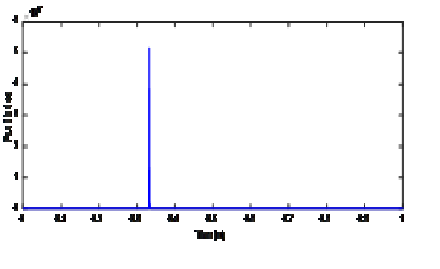
- FI for current in phase-A during LL fault on phases-A&B.
The double line (LL) fault is created by short circuiting the phases-A&B at middle of the line connected between the nodes 632 and 671 of the test system in the simultaneous presence of the wind and solar PV power generation. The current of phase-B recorded on bus 632 of the test system has been processed using DWT using db4 mother wavelet for four decomposition levels. Proposed fault index is calculated from the detailed coefficient at first level of decomposition and provided in Fig. 6. This is evaluated from Fig. 6 that magnitudes of the proposed fault index are zero in both the pre-fault and post fault conditions. However, these values are higher compared to 4×106 indicating the faulty phase during the event of LL fault.
The double line (LL) fault is created by short circuiting the phases-A & B at middle of the line connected between the nodes 632 and 671 of the test system in the simultaneous presence of the wind and solar PV power generation. The current of phase-C recorded on bus 632 of the test system has been processed using DWT with db4 mother wavelet for four levels of decomposition. Proposed fault index is calculated from the detailed coefficient at first level of decomposition and provided in Fig. 7. This is inferred from Fig. 7 that magnitudes of the proposed fault index are zero in both the pre-fault and post fault conditions. However, these values are high and equal to 2×106 but less than the threshold value of 4×106 indicating the healthy phase during the event of LL fault.
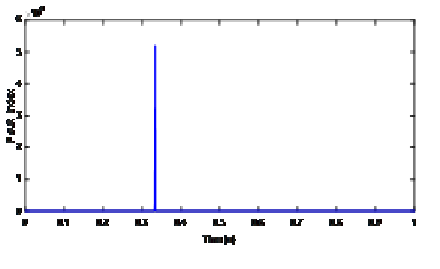
- FI for current in phase-B during LL fault on phases-A&B.
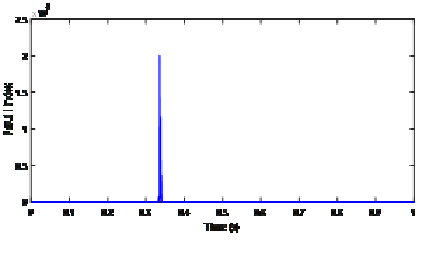
- FI for current in phase-C during LL fault on phases-A&B.
- LLG Fault Event
The LLG fault event is performed by grounding phases-A&B on same moment at middle of the line connected between the nodes 632 and 671 of the test system in simultaneous presence of the wind and solar PV power generation. The current of phase-A recorded on bus 632 of the test system has been processed using DWT using db4 mother wavelet for four levels of decomposition. Proposed fault index is calculated from the detailed coefficient at first level of decomposition and provided in Fig. 8. This is evaluated from Fig. 8 that magnitudes of proposed fault index are zero in both the pre-fault and post fault conditions. However, these values are high and equal to the 4.2×107 during the events of LLG fault indicating the occurrence of the fault in the test grid. A threshold value equal to 3×107 has been selected for discrimination of the LLG fault from the other faults as well as the faulty phases from the healthy phase during the event of LLG fault. The values of proposed fault index higher than 3×107 indicates the presence of the LLG fault in the test grid network.
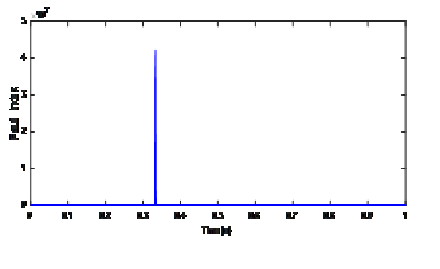
- FI for current in phase-A during LLG fault event on phases-A&B.
The LLG fault is created by short circuiting the phases-A&B at middle of the line connected between the nodes 632 and 671 of the test system in the simultaneous presence of the wind and solar PV power generation. The current of phase-B recorded on bus 632 of the test system has been processed using DWT with db4 mother wavelet for four decomposition levels. Proposed fault index is calculated from the detailed coefficient at first level of decomposition and provided in Fig. 9. This is evaluated from Fig. 9 that magnitudes of proposed fault index are zero in both the pre-fault and post fault conditions. However, these values are higher compared to 4×106 indicating the faulty phase during scenario of LLG fault.
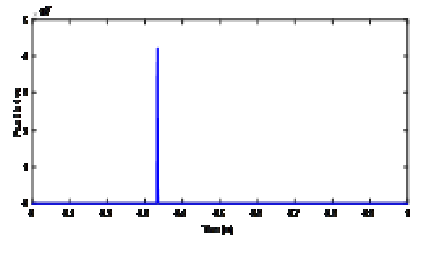
- FI for current in phase-B during LLG fault event on phases-A&B.
The LLG fault is created by short circuiting the phases-A & B at middle of the line connected between the nodes 632 and 671 of the test system in the simultaneous presence of the wind and solar PV power generation. The current of phase-C recorded on bus 632 of the test system has been processed by the use of DWT with db4 mother wavelet for four decomposition levels. Proposed fault index is calculated from the detailed coefficient at first level of decomposition and provided in Fig. 10. This is evaluated from Fig. 10 that the values of the proposed fault index are zero in both the pre-fault and post fault conditions. However, these values are high and equal to 2.2×105 but less than the threshold value of 4×106 indicating the healthy phase during scenario of LLG fault.
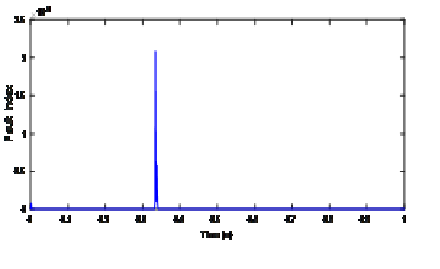
- FI for current in phase-C during LLG fault event on phases-A&B.
- LLLG Fault Event
The LLLG fault is created by simultaneous grounding of all the three phases at middle of the line connected between the nodes 632 and 671 of the test system in simultaneous presence of the wind and solar PV power generation. The current of phase-A recorded on bus 632 of the test system has been processed by application of DWT using db4 mother wavelet for four levels of decomposition. Proposed fault index is calculated from the detailed coefficient at first level of decomposition and provided in Fig. 11. This is evaluated from Fig. 11 that magnitudes of proposed fault index are zero in both the pre-fault and post fault conditions. However, these values are high and equal to the 14×107 during the events of LLLG fault indicating the occurrence of the fault in the smart grid. A threshold value equal to 12×107 has been selected for discrimination of the LLLG fault from the other faults. The values of proposed fault index and higher than 12×107 indicate the presence of the LLLG fault in the test grid network.
The three-phase fault involving ground (LLLG) fault is created by short circuiting all the three phases at middle of the line connected between the nodes 632 and 671 of the test system in the simultaneous presence of the wind and solar PV power generation. The current of phase-B recorded on bus 632 of the test system has been processed using DWT with db4 mother wavelet for four levels of decomposition. Proposed fault index is calculated from the detailed coefficient at first level of decomposition and provided in Fig. 12. This is evaluated from Fig. 12 that magnitudes of proposed fault index are zero in both the pre-fault and post fault conditions. However, these values are higher compared to 3×107 indicating the faulty phase during scenario of LLLG fault.
| Type of Fault | Phase-A | Phase-B | Phase-C | Threshold based for phase-A |
| LG | 9.00×107 | 1.30×105 | 1.30×105 | 7.00×107 |
| LL | 5.00×107 | 5.00×107 | 2.00×106 | 4.50×107 |
| LLG | 4.00×107 | 4.00×107 | 2.00×105 | 1.00×107 |
| LLLG | 1.40 x108 | 4.00×107 | 4.00×107 | 1.00×108 |
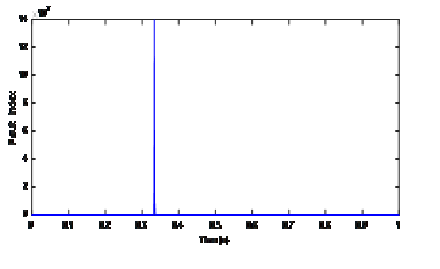
- FI for current in phase-A for LLLG fault event
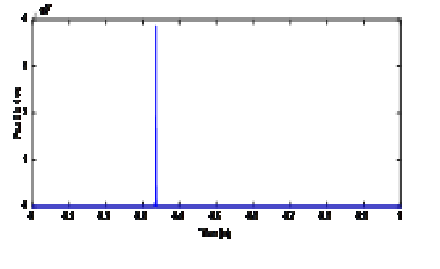
- FI for current in phase-B during LLLG fault.
The three-phase fault involving ground (LLLG) fault is created by short circuiting all the three phases at middle of the line connected between the nodes 632 and 671 of the test system in the simultaneous presence of the wind and solar PV power generation. The current of phase-B recorded on bus 632 of the test system has been processed by application of DWT using db4 as mother wavelet for four levels of decomposition. Proposed fault index is calculated from the detailed coefficient at first level of decomposition and provided in Fig. 13. This is inferred from Fig. 13 that magnitudes of proposed fault index are zero in both the pre-fault and post fault conditions. However, these values are higher compared to 3×107 indicating the faulty phase during scenario of LLLG fault.
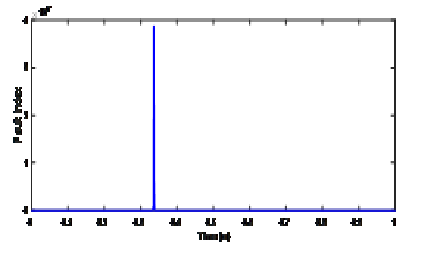
- FI for current in phase-C during LLLG fault.
- Classification of Faults in the Hybrid Smart Grid
The peak values of the fault indices for all the three phases during the events of different nature of faults like LG, LL, LLG and LLLG in the test grid in the presence of both solar PV power generation and wind energy conversion system have been provided in the Table 5. The values of proposed thresholds to identify and to discriminate of different types of faults have also been presented in this Table 5. The values provided in the Table 5 are taken as input to RBDT for classifying the faults. The threshold values provided in the Table 5 are taken as references for design of the decision rules used for the classification purpose. The flow chart used by the RBDT for classifying different types of faults in the test grid in the presence of both solar PV power and wind power generations is sown in Fig. 14.
- Peak Magnitudes of Fault Indices and Threshold Magnitudes in the Test Power System
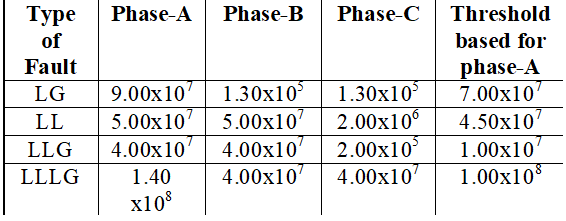
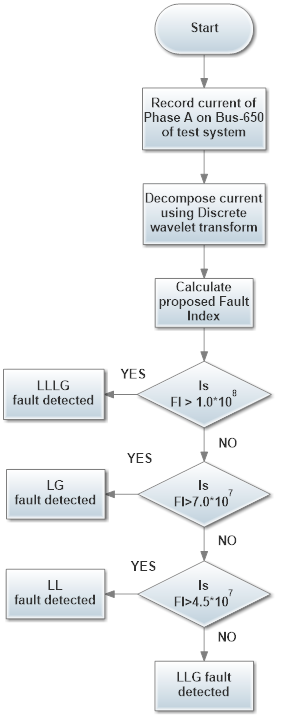
- Flow chart used for classification of the faults using rule based decision tree.
6. Performance Comparison
Performance of DWT and RBDT based algorithm designed in this paper is compared with the algorithm reported in [5]. It is established that the algorithm reported in [5] can only be applied for the recognition of fault events with solar energy. The algorithm is not tested for the hybrid power systems. However, the algorithm introduced in this paper can be applied for identification of the faults in the presence of both the wind and solar power generation. Hence, proposed method can be used for designing the protection schemes in the present day hybrid power systems.
7. Conclusions
A current based fault detection method to design protection scheme for the hybrid power system in the presence of both wind and solar power generation is introduced in this paper. It is concluded that the proposed algorithm detects the faults in the hybrid power system using the current signals. Algorithm effectively recognized the faulty events such as LG, LL, LLG and LLLG faults. Performance of technique is established to be better compared to method reported in literature with different features.
References
- Bhuvnesh Rathore, Om Prakash Mahela, Baseem Khan, Hassan Haes Alhelou, Pierluigi Siano, “Wavelet-Alienation-Neural Based Protection Scheme for STATCOM Compensated Transmission Line,” IEEE Transactions on Industrial Informatics, Volume: 17, Issue: 4, April 2021, DOI: 1109/TII.2020.3001063
- Atul Kulshrestha, Om Prakash Mahela, Mukesh Kumar Gupta, Neeraj Gupta, Nilesh Patel, Tomonobu Senjyu, Mir Sayed Shah Danish, Mahdi Khosravy, “A Hybrid Protection Scheme Using Stockwell Transform and Wigner Distribution Function for Power System Network with Solar Energy Penetration, Energies 2020, 13(14), 3519, Doi: https://doi.org/10.3390/en13143519
- Govind Sahay Yogee, Om Prakash Mahela, Kapil Dev Kansal , Baseem Khan, Rajendra Mahla, Hassan Haes Alhelou, Pierluigi Siano, “An Algorithm for Recognition of Fault Conditions in the Utility Grid with Renewable Energy Penetration,” Energies, 13(9), 2383, https://doi.org/10.3390/en13092383.
- Sheesh Ram Ola, Amit Saraswat, Sunil Kumar Goyal, S. K. Jhajharia and Om Prakash Mahela. Detection and Analysis of Power System Faults in the Presence of Wind Power Generation Using Stockwell Transform Based Median, Springer Lecture Notes in Electrical Engineering Series, ISSN: 1876-1100, 319-329, 2019. https://link.springer.com/chapter/10.1007/978-981-15-0214-9_36.
- Atul Kulshrestha, Om Prakash Mahela, Mukesh Kumar Gupta, “Identification and Classification of Faults in Utility Grid with Solar Energy Using Discrete Wavelet Transform and Decision Rules,” 12th IEEE International Conference on Computational Intelligence and Communication Networks (CICN 2020), September 24-25, 2020, Bhimtal, India, DOI: 1109/CICN49253.2020.9242564.
- Amit Kumar Gangwar, Bhunesh Rathore, Om Prakash Mahela, K-means Clustering and Linear Regression Based Protection Scheme for Transmission Line, IEEE 9th Power India International Conference (PIICON 2020) from 28 Feb to 01 March, 2020 – Deenbandhu Chhotu Ram University of Science and Technology, Murthal, India, DOI: 1109/PIICON49524.2020.9113038.
- Nikita Tailor, Satyanarayan Joshi, Om Prakash Mahela, Transmission Line Protection Schemes Based on Wigner Distribution Function and Discrete Wavelet Transform, IEEE 9th Power India International Conference (PIICON 2020) from 28 Feb to 01 March, 2020 – Deenbandhu Chhotu Ram University of Science and Technology, Murthal, India, DOI: 1109/PIICON49524.2020.9113011
- Mohd Zishan Khoker, Om Prakash Mahela, and Gulhasan Ahmad, A Voltage Algorithm using Discrete Wavelet Transform and Hilbert Transform for Detection and Classification of Power System Faults in the Presence of Solar Energy, 2020 IEEE International Students’ Conference on Electrical, Electronics and Computer Science (SCEECS 2020), MANIT Bhopal, India, February 22-23, 2020, DOI: 1109/SCEECS48394.2020.7
- Mohd Zishan Khoker, Om Prakash Mahela, and Gulhasan Ahmad, A Current Based Hybrid Algorithm using Discrete Wavelet Transform and Hilbert Transform for Detection and Classification of Power System Faults in the Presence of Solar Energy, 2020 IEEE International Students’ Conference on Electrical, Electronics and Computer Science (SCEECS 2020), MANIT Bhopal, India, February 22-23, 2020, DOI: 1109/SCEECS48394.2020.6
- Shubhmay Karmakar, Gulhasan Ahmad, Om Prakash Mahela, and Ravi Raj Choudhary, Algorithm Based on Combined Features of Stockwell Transform and Hilbert Transform for Detection of Transmission Line Faults with Dynamic Load, First IEEE International Conference on Power, Control and Computing Technologies (ICPC2T), NIT Raipur, India, January 3-5, 2020, DOI: 1109/ICPC2T48082.2020.9071516.
- Shubhmay Karmakar, Gulhasan Ahmad, Om Prakash Mahela, and Ravi Raj Choudhary, Transmission Line Protection Scheme Based on Combined Features of Stockwell Transform and Hilbert Transform, First IEEE International Conference on Power, Control and Computing Technologies (ICPC2T), NIT Raipur, India, January 3-5, 2020, DOI: 1109/ICPC2T48082.2020.9071506.
- Surbhi Thukral, Om Prakash Mahela, Bipul Kumar, Detection of Transmission Line Faults in the Presence of Wind Energy Power Generation Source Using Stockwell’s Transform, IEEE International Conference on Issues and Challenges in Intelligent Computing Techniques (ICICT 2019), 27-28th September, 2019, KIET Group of Institutions, Delhi-NCR, Ghaziabad, India, DOI: 1109/ICICT46931.2019.8977695.
- Ravi Kishor Ranjan, Om Prakash Mahela, Sunil Agarwal, Bhuvnesh Rathore, Algorithm for Detection of Power System Faults in the Presence of Thyristor Controlled Reactor Using Hilbert Huang Transform and Ruled Decision Tree, IEEE International Conference on Computing, Power and Communication Technologies (GUCON 2019), September 27-28, 2019.
- Rajesh Kumar, Om Prakash Mahela, Mahendra Kumar, Nitin Kumar Suyan, Neeraj Kumar, A Current Based Algorithm Using Harmonic Wavelet Transform and Rule Based Decision Tree for Transmission Line Protection, 4th International Conference On Internet of Things: Smart Innovation and Usages (IoT-SIU 2019), 18-19 April, 2019, Krishna Engineering College, Ghaziabad, Uttar Pradesh, India, DOI: 1109/IoT-SIU.2019.8777667
- Sheesh Ram Ola, Amit Saraswat, Sunil Kumar Goyal, S. K. Jhajharia, and Om Prakash Mahela. A Technique Using Stockwell Transform Based Median for Detection of Power System Faults. In: 2018 IEEE 8th Power India International Conference (PIICON-2018), NIT Kurukshetra, India, December 10-12, 2018, DOI: 1109/POWERI.2018.8704459
- Balvinder Singh, Om Prakash Mahela and Tanuj Manglani. Detection and Classification of Transmission Line Faults Using Empirical Mode Decomposition and Rule Based Decision Tree Based Algorithm. In: 2018 IEEE 8th Power India International Conference (PIICON 2018), NIT Kurukshetra, India, December 10-12, 2018, DOI: 1109/POWERI.2018.8704372,
- Akanksha Malhotra, Om Prakash Mahela and Himanshu Doraya. Detection and Classification of Power System Faults Using Discrete Wavelet Transform and Rule Based Decision Tree. In: IEEE International Conference on Computing, Power and Communication Technologies 2018 (GUCON 2018), Galgotias University, Greater Noida, India, September 28-29, 2018, DOI: 1109/GUCON.2018.8674922
- Gajanand Sharma, Om Prakash Mahela, Mahendra Kumar and Neeraj Kumar. Detection and Classification of Transmission Line Faults Using Stockwell Transform and Rule Based Decision Tree. In: IEEE PES International Conference on Smart Electric Drives and Power System (ICSEDPS-2018), G H Raisoni College of Engineering, Nagpur, India, June 12-13, 2018, DOI: 1109/ICSEDPS.2018.8536006
- Rashmi Sharma, Om Prakash Mahela and Sunil Agarwal. Detection of Power System Faults in Distribution System Using Stockwell Transform. In: 2018 IEEE Students’ Conference on Electrical, Electronics and Computer Science (SCEECS 2018), MANIT, Bhopal, India, February 24-25, 2018, DOI: 1109/SCEECS.2018.8546879
- Om Prakash Mahela, Gulhasan Ahmad and Sheesh Ram Ola. Detection of Transmission Line Faults in the Presence of Thyristor Switched Capacitor Using Stockwell Transform. In: 2018 IEEE Students’ Conference on Electrical, Electronics and Computer Science (SCEECS 2018), MANIT, Bhopal, India, February 24-25, 2018, DOI: 1109/SCEECS.2018.8546980
- Gulhasan Ahmad, Om Prakash Mahela and Sheesh Ram Ola. A Stockwell Transform Based Approach for Detection of Transmission Line Faults in the Presence of Thyristor Controlled Reactor. In: IEEE International Conference SPIN 2018, Galgotia University, Greater Noida, India, February 22-23, 2018, DOI: 1109/SPIN.2018.8474098
- Amit Kumar Gangwar, Om Prakash Mahela, Bhuvnesh Rathore, Baseem Khan, Hassan Haes Alhelou, and Pierluigi Siano, “A Novel K-Means Clustering and Weighted K-NN Regression Based Fast Transmission Line Protection, IEEE Transactions on Industrial Informatics, Early Access, November 2020, DOI: 1109/TII.2020.3037869
- Rajkumar Kaushik, Om Prakash Mahela, Pramod Kumar Bhatt , Baseem Khan, Akhil Ranjan Garg, Hassan Haes Alhelou, and Pierluigi Siano, “Recognition of Islanding and Operational Events in Power System with Renewable Energy Penetration Using a Stockwell Transform Based Method”, IEEE Systems Journal, 2020, DOI: 10.1109/JSYST.2020.3020919
- Sheesh Ram Ola, Amit Saraswat, Sunil Kumar Goyal, S. K. Jhajharia, Bhuvnesh Rathore, Om Prakash Mahela, Wigner Distribution Function and Alienation Coefficient Based Transmission Line Protection Scheme, IET Generation, Transmission and Distribution, Volume 14, Issue 10, 22 May 2020, 1842 – 1853, DOI: 10.1049/iet-gtd.2019.1414
- Om Prakash Mahela, Jaya Sharma, Bipul Kumar, Baseem Khan, Hasan Haes Alhelou, “An Algorithm for the Protection of Distribution Feeder Using Stockwell and Hilbert Transforms Supported Features,” CSEE Journal of Power and Energy Systems, 2020, DOI: 17775/CSEEJPES.2020.00170
- Sheesh Ram Ola, Amit Saraswat , Sunil Kumar Goyal, S. K. Jhajharia, Baseem Khan , Om Prakash Mahela, Hassan Haes Alhelou, and Pierluigi Siano, A Protection Scheme for Power System with Solar Energy Penetration, Applied Sciences 2020, Vol. 10, Issue 4, Paper No. 1516, pp. 1-22, Feb. 2020, DOI: https://doi.org/10.3390/app10041516
- Sheesh Ram Ola, Amit Saraswat, Sunil Kumar Goyal, Virendra Sharma,
Baseem Khan, Om Prakash Mahela, Hassan Haes Alhelou, Pierluigi Siano, Alienation Coefficient and Wigner Distribution Function Based Protection Scheme for Hybrid Power System Network with Renewable Energy Penetration, Energies 2020, Vol. 13, Issue 5, Paper No. 1120, March 2020, DOI: https://doi.org/10.3390/en13051120 - Atul Kulshrestha, Om Prakash Mahela, Mukesh Kumar Gupta, Baseem
Khan, Hassan Haes Alhelou, Pierluigi Siano,” Hybridization of Stockwell Transform and Wigner Distribution Function to Design Transmission Line Protection Scheme, Applied Sciences 2020, Volume 10, Issue 22, 7985, https://doi.org/10.3390/app10227985 - Kersting, W.H., “Radial distribution test feeders,” IEEE Transation on Power System, 1991, 6, 975–985, doi:10.1109/59.119237.
- Abdul Gafoor Shaik and Om Prakash Mahela, Power quality assessment and event detection in hybrid power system, Electric Power Systems Research (Elsevier), Volume 161, March 2018, Pages 26-44.
- Om Prakash Mahela, Kapil Dev Kansal and Sunil Agarwal. Detection of Power Quality Disturbances in Utility Grid with Wind Energy Penetration. In: 8th IEEE India International Conference on Power Electronics (IICPE-2018), MNIT Jaipur, India, December, 13-14, 2018.
- Om Prakash Mahela, Kapil Dev Kansal and Sunil Agarwal. Detection of Power Quality Disturbances in Utility Grid with Solar Photovoltaic Energy Penetration. In: 8th IEEE India International Conference on Power Electronics (IICPE-2018), MNIT Jaipur, India, December 13-14, 2018, DOI:1109/IICPE.2018.8709597.
